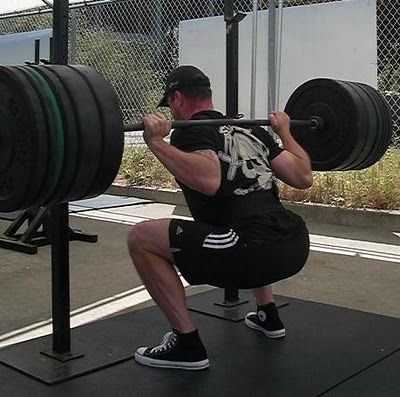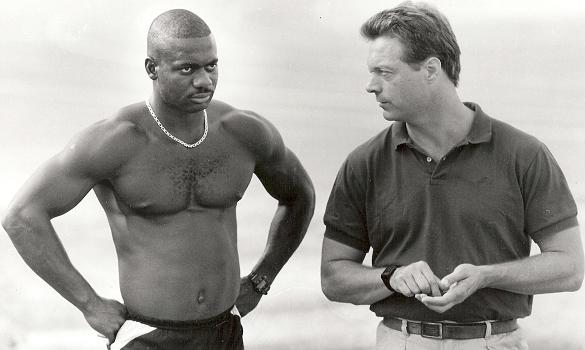I have been working my way through Easy Strength by Dan John and Pavel. If you are a coach, of any sport, reading it should prerequisite to taking that job. If you're an athlete or self-trained person (like a weekend warrior), this book will change the way you approach training- definitely for the better. Between the two men, there is much wisdom packed into their words that I find myself taking notes on every page. Seriously, if you're serious about training, you need to read this book.
Dan John posited a fantastic question regarding training priorities that I wanted to pass along to our SAPT readers.
"Let's say, for some reason, you've found that you can only train for a total 45 minutes a week. Maybe you've become a political prisoner or something. You'll only be able to get in three workouts of 15 minutes each. What will you do?"
Not only does it put my own training into perspective, but that of the athletes I coach. The answer to the question reveals where you should be spending the majority of your time and energy. As Dan John says, "Training sessions should put your on the path of progress toward your goals."
We humans are finite (this isn't going to get metaphorical so stick with me) and therefore have a finite amount of energy, time, and capacity for adaptation/recovery. In contrast to our in-born capacity, we live in the age of programs like p90X/Insanity (do everything as fast as you can), Crossfit (train everything to the max all the time), and the pervasive mentality that a "good" workout or practice should encompass every possible variation of an exercise/drill and should last a long time. But remember, we're finite!
Thus, anything you're doing that does not directly relate to your overall physical goal will only take away from your ability to achieve your goal.
Refer back to Dan John's question, if you only have 15 minutes to train/practice, what are you going to do? If you're an athlete (or the coach of athletes) what skills would most benefit you/the team to master? If you're a regular trainee, what exercises will bring your closer to your goal- be it lose 10 lbs, or bench 225, or compete in a Sand Race. Find these core elements and devote your energy and time to them.
I'll use myself as an example.
My goal: deadlift 300lbs and perform 20 pull ups in a row.
Conveniently (or not), I also have chronic Lyme disease and over the past year, I've found that I only really have enough gas in my tank for about 20 minutes of hard training. (This is a far cry from what I'm used to.) Even before reading Easy Strength I had to pare down my training considerably base on my energy levels and joint pain. So, Dan John's question was perfect! It did two things: 1) trim my workouts down a bit more, which I believe will make them more effective and 2) encourage me that I'm not being a wimp for eliminating excessive accessory work. My capacity for recovery is also inhibited, so I need to be extra careful with exercise selection as, again, anything that is outside of my goal will only take away from its accomplishment.
Therefore, here is my training split:
Monday
Deadlift- currently I'm in a higher volume cycle, so I perform 2-3 series of (1, 3, 5, 7) reps.
Handstand pushups, skater squats, band rows- 3 easy sets of 6-8 each
Tuesday
BB Front Squat Grip Step Back Lunge- (the only single leg movement I can perform without pain). My weakest link in my deadlift and pull ups is my upper back. This variation keeps my legs balance (because it's unilateral work) but also nails my upper back. - 5x5
NG Chin Ups= total of 50 reps. I'm working at increasing the number of chin ups per set and reducing the number of sets I have to do.
BB Back ele. Glute Bridge- stronger butt = stronger deadlift 3-4x8
Band-resisted Pushups 3x8
Wednesday
Aerobic Power Circuit, performed for 15-18 minutes:
Heavy swings x 10
Pull ups x 4-5
Feet Ele. Push ups x 12
Weighted Crawls x 4 trips
Thursday
Snatch Grip Deadlift- I chose this because of my stupidly weak upper back, so this variation hammers it. I also focus on moving the bar fast to work on the speed of my pull.
GHR, weighted pushups, inverted rows- 3 easy sets of 8 each
Friday
Easy movement day and crawling- I use this day to move around and work out any kinked up joints but nothing terribly difficult.
I also start each session with some kettlebell swings. I like them because they warm up my nervous system and get my glutes firing on all cylinders. All of my accessory work aids in deadlifting and/or pull ups (glute work, upper back, and core strength). I train my core through my pushups and crawling. I perform step back lunges because a) I can't deadlift every day (darn!) and b) I can't squat any more and these fit the bill for challenging my upper back, core, and glutes.
On all of my days, the main focus (the deadlift or the lunges/chin ups) take only about 15-20 minutes, including my warm ups. The accessory work I keep at a lower intensity and I use primarily for focusing more intently on my "deadlifting" muscles. It's not a perfect plan by any means, but it's all geared towards increasing my deadlift and pull ups.
I encourage you, reader, to find out what you would do with your 15 minutes.



